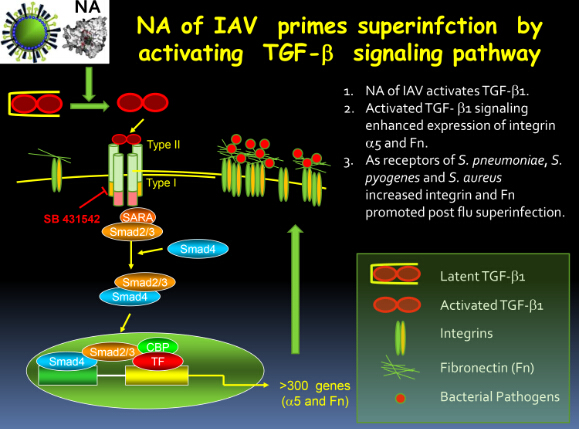Bacterial co-infection is the leading cause of viral-associated mortality during influenza A virus (IAV) pandemic. Some evidence suggests that IAV neuraminidase (NA) substantially contributes to the adherence. However, the underlying mechanisms remain elusive.
Adherence to host tissue is a critical initial step to establish infection. The most frequently observed bacteria in co-infections are S. pneumoniae, S. pyogenes, S. aureus and H. influenza, which all require extracellular matrix (ECM) components, such as fibronectin (Fn) or integrins as receptors for adherence. TGF-β enhances expression of these molecules and IAV NA triggers TGF-β activation. These observations suggest a connection between NA, TGF-β and co-infection.
Prof. WANG Beinan and her colleagues at the Institute of Microbiology of Chinese Academy of Sciences (IMCAS) demonstrated that IAV increases TGF-β activity and enhances bacterial adherence to human lung epithelial cells. The adherence is enhanced through recombinant viral NA and prevented through the inhibition of TGF-β signaling. Further examination of expression of cellular receptors showed that α5 integrin and Fn are enhanced through IAV or NA and prevented by inhibitors of TGF-β1 and NA. This demonstrates that activation of TGF-β by viral NA enhances cellular adhesins which leads to increased susceptibility of host to bacterial infection.
The group studied bacterial side of the interaction and found that IAV is not able to promote the adherence if a bacterium does not express Fn-binding protein. This demonstrates that IAV-enhanced bacterial adherence is Fn-binding protein dependent. Consistent with this, all frequently reported co-infecting pathogens express Fn-binding proteins. The experiments showed that inhibition of TGF-β signaling significantly prevents adherence of these pathogens.
The researchers confirmed the findings in vivo which show that IAV infection increases bacterial colonization in the lungs of wild-type mice but not in TGF-β signaling deficient mice.
The results reveal a previously unrecognized mechanism of the relationship between IAV, bacteria and the host in flu pathogenesis. It suggests that the bacteria commonly observed in co-infection likely share a similar mechanism for the initiation of an infection. Interventions targeting these mechanisms might reduce the incidence and severity of post-flu bacterial pneumonia.
The study was published on “Proceedings of the National Academy of the Sciences ”.

Figure. IAV facilitates bacterial adherence through the activation of the TGF-b signaling pathway. (Image by Prof. WANG’s lab)